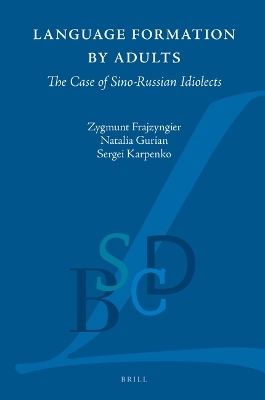
Language Formation by Adults
Brill (Verlag)
978-90-04-46329-5 (ISBN)
Chinese immigrants who settle in Russia’s Far East without formal instruction in the Russian language communicate with local Russians using Russian vocabulary. Each immigrant forms their language to communicate with Russians, not with family or other immigrants. The ‘single-generation languages’ that immigrants form are not replications or simplifications of Chinese or Russian. Grammatical systems formed by these speakers challenge some fundamental assumptions in early 21st-century linguistic theories. Grammatical systems of single-generation languages provide a unique window into how complex grammatical systems emerge, what are the first formal means of expression, and what are the first meanings expressed in grammatical systems. Given massive migrations in the contemporary world, single-generation languages are common, yet understudied, products of language contact.
Zygmunt Frajzyngier, Ph.D. (1968), University of Warsaw, is Professor of Linguistics at the University of Colorado in Boulder. He has published many books on African languages and syntax and semantics from a cross-linguistic perspective. Most recently he published, with Marielle Butters, The emergence of grammatical functions (2020, Oxford University Press). Natalia Gurian, Ph.D. (2009), Lomonosov Moscow State University, Institute of Asian and African Studies, is Associate Professor at the Department of Education in Oriental Languages and Oriental Studies, School of Education, Far Eastern Federal University (Russia). Sergei Karpenko, Ph.D. (2007), Barnaul State Pedagogical University, is Associate Professor at Department of Romance and German Languages, Far Eastern Federal University (Russia). Recent publication by the authors together: Frajzyngier, Zygmunt; Natalia Gurian; and Sergei Karpenko (2020). Language contact: Sino-Russian in Handbook of language contact, 2nd ed. R. Hickey (ed.). Wiley Online Library, pp. 689-715.
Acknowledgments
Abbreviations
1 Introduction
1 The aim of the work
2 The languages
3 The importance of this study
4 Previous research
5 Sino-Russian idiolects are not ‘new varieties’
6 Previous research on Sino-Russian
7 Methodology
8 The data
9 A note about glossing convention
2 Phonology
1 Previous scholarship on phonology
2 Segmental structure, constraints and rules of Mandarin
3 Segmental structure, constraints and rules of Russian
4 The Sino-Russian segmental inventory
5 Resolution of features and phonotactic constraints
6 Phonotactics
7 The dental sonorants: r, l and n distinction
8 Stress assignment
9 Conclusions and implications about phonology
3 Other formal means of coding
1 Introduction to formal means
2 The category ‘word’
3 Pauses
4 Linear orders as a coding means
5 Free grammatical morphemes
6 Conclusions regarding the formal means of coding in Sino-Russian
4 Lexicons of the Sino-Russian idiolects
1 Aim of the chapter
2 Lexical categories
3 Number of words and number of different words in the texts
4 Lexical convergence
5 The choice of lexical items
6 Conclusions about lexical items
5 The emergence of phrasal categories
1 The importance of the chapter
2 The emergence of the noun phrase
3 The emergence of prepositional phrases
4 Numeral phrases
5 Verb phrases (lack of)
6 The role of pauses in defining the phrasal structure
7 Conclusion about the emergence of phrasal categories
6 The noun phrase
1 The defining features and the formal means of coding within the noun phrase
2 Inceptive coding of number
3 Modification of one noun by another
4 Modification by a pronoun
5 Modification by a property concept
6 Modification by a quantifier
7 Conclusions about noun phrase
7 System of reference
1 Introduction
2 The formal coding means
3 Introduction of new entities in discourse
4 Coding an unknown member of a set
5 Reference left to listener’s computation
6 Switch reference within discourse: the function of pronouns
7 Deixis
8 Anaphora
9 Unspecified entity
10 Locative anaphora
11 Conclusions about the system of reference
8 Antecedent-follow up relation
1 The role of pauses
2 The antecedent-comment distinction
3 Utterance-internal pauses
4 Discourse connection
5 Non-propositional addressee and presentative function
6 Conclusions
9 Modality
1 Introduction
2 Assertive modality
3 Interrogative modality
4 Negation
5 Imperative: Expectation of the immediate implementation
6 Obligation without the expectation of implementation
7 Optative or purpose function
8 Prohibitive modality
9 Conclusions about modality
10 Aspectual system
1 Aspectual systems in Russian and in Mandarin
2 Punctual aspect
3 Progressive aspect
4 Conclusions about the emergence of aspect
11 Tense system
1 Introduction
2 Emergence of a future tense
3 The emergence of the past tense
4 Time in relation to another time
5 Conclusion about tense system
12 Non-verbal predications
1 Introduction
2 The role of linear order in verbless predications
3 Identificational predication
4 Possessive predication
5 Equational predication
6 Attributive predication
7 Quantifier as a predicate
8 Existential predication
9 Conclusions about verbless clauses
13 Relations between the verbal predicate and noun phrases
1 Theoretical issues
2 Position of the verbal predicate
3 Omission of the predicate
4 Clauses without noun phrases
5 Number of arguments in a Sino-Russian clause
6 The order of arguments in the clause
7 The semantic role of the single noun phrase in a verbal clause
8 Argument versus adjunct distinction
9 Coding of semantic relations of noun phrases
10 Locative complements
11 Do the categories subject and object exist in Sino-Russian idiolects?
12 Conclusions regarding the relations between the verbal predicate and noun phrases
14 Situating the Event in Here and Now
15 Adverbs of Manner
1 The Importance of the Chapter
2 Adverbs of Manner in Sino-Russian Idiolects
3 Conclusions Concerning the Position of Adverbs
16 Comment clause
1 The category comment clause
2 The functions of the comment clause
3 The emergence of the comment clause as a function
4 Conclusions about the comment clause
17 Topicalization
1 Introduction
2 Topicalization through the use of prepositions
3 Topicalization and the role of the pause
4 Topicalization of noun phrases and prepositional phrases
5 Topicalization through the use of the demonstrative ʹɛta
6 Conclusions about topicalization
18 Relations between propositions
1 Introduction
2 Default propositional relation
3 Unexpected follow-up
4 Discourse connection
5 Conclusions about relationship between propositions
19 Complementation
1 Introduction
2 Complements of verbs of saying
3 Complements of cognitive verbs
4 Modality of obligation and wish in complement clause
5 Complements of the verbs of liking and loving
6 Complements of verbs of perception
7 Complements of volitional verbs
8 Complements of cognitive verbs
9 Purpose clause
10 Reason clause
11 Relative clause
12 Conclusions about complementation and subordination
20 Comparative predications
1 Introduction
2 Equal comparison
3 Unequal comparison
4 Conclusions about comparative constructions
21 Summary and implications
1 The scope of the chapter
2 The coding means
3 The functions
4 Implications for linguistic theory and methodology
5 Understanding the Sino-Russian idiolects
6 Sino-Russian idiolects and language contact
7 The grammar formation process
8 Lexical items and lexical categories
9 Open questions
22 Sample of texts
1 Boris: Bread and sausage
2 Ivan
3 Lida
4 Sveta about her work
5 Sveta about the New Year celebration
6 Sveta about food
7 Sveta about Russians
8 Sveta about food
9 Anonymous
10 Nina
11 Sveta ‘Wolf and rabbit’
12 Lyuda
13 Slava
14 Egor
15 Andrey
16 Konstantin. Narration of the ‘Pear story’.
17 Fedya about himself
18 Anna about herself
19 Anna about language learning
20 Anna’s Pear Story
References
Index
| Erscheinungsdatum | 17.09.2021 |
|---|---|
| Reihe/Serie | Brill Studies in Language Contact and the Dynamics of Language ; 2 |
| Verlagsort | Leiden |
| Sprache | englisch |
| Maße | 155 x 235 mm |
| Gewicht | 745 g |
| Themenwelt | Geisteswissenschaften ► Sprach- / Literaturwissenschaft ► Sprachwissenschaft |
| ISBN-10 | 90-04-46329-1 / 9004463291 |
| ISBN-13 | 978-90-04-46329-5 / 9789004463295 |
| Zustand | Neuware |
| Haben Sie eine Frage zum Produkt? |
aus dem Bereich


